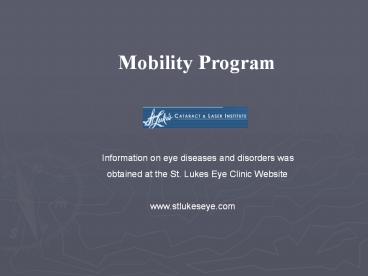Human Resource Development - PowerPoint PPT Presentation
1 / 13
Title:
Human Resource Development
Description:
Mobility Program Blindness Facts Mobility Program Macular Degeneration A degenerative condition of the macula (the ... and its prevalence increases with age. – PowerPoint PPT presentation
Number of Views:45
Avg rating:3.0/5.0
Title: Human Resource Development
1
Mobility Program
Information on eye diseases and disorders was
obtained at the St. Lukes Eye Clinic Website
www.stlukeseye.com
2
Mobility Program
Blindness Facts
3
Mobility Program
Macular Degeneration
A degenerative condition of the macula (the
central retina). It is the most common cause of
vision loss in the United States in those 50 or
older, and its prevalence increases with age. It
is caused by hardening of the arteries that
nourish the retina. This deprives the sensitive
retinal tissue of oxygen and nutrients that it
needs to function and thrive. As a result, the
central vision deteriorates.
4
Mobility Program
Macular Degeneration
Patients with wet macular degeneration develop
new blood vessels under the retina. This causes
hemorrhage, swelling, and scar tissue but it can
be treated with laser in some cases.
5
Mobility Program
Macular Degeneration
Dry macular degeneration, although more common,
typically results in a less severe, more gradual
loss of vision.
It is characterized by drusen and loss of
pigment in the retina. Drusen are small,
yellowish deposits that form within the layers
of the retina.
Drusen
6
Mobility Program
Diabetic Retinopathy
The effect of diabetes on the eye is called
diabetic retinopathy. Over time, diabetes
affects the circulatory system of the retina.
7
Mobility Program
Diabetic Retinopathy
The earliest phase of the disease is known as
background diabetic retinopathy. In this phase,
the arteries in the retina become weakened and
leak, forming small, dot-like hemorrhages.
The next stage is known as proliferate diabetic
retinopathy. In this
stage, circulation problems
cause areas of the retina to become
oxygen-deprived or ischemic. New, fragile,
vessels
develop as the circulatory system
attempts to maintain
adequate oxygen levels
within the retina. This is
called neovascularization.
Unfortunately, these delicate vessels
hemorrhage
easily.
8
Mobility Program
Cataracts
When cataracts are mentioned, people often think
of a film that grows on their eyes causing them
to see double or blurred images. However, a
cataract does not form on the eye, but rather
within the eye.
9
Mobility Program
Cataracts
A cataract is a clouding of the natural lens,
the part of the eye responsible for focusing
light
and producing clear, sharp images. The
lens is
contained in a sealed bag or capsule. As old
cells
die they become trapped within the
capsule.
Over time, the cells
accumulate causing the lens
to
cloud, making images look blurred or fuzzy.
For most people, cataracts are a natural
result of aging.
10
Mobility Program
Glaucoma
Glaucoma is a disease caused by increased
intraocular pressure (IOP) resulting either
from a malformation or malfunction of the eyes
drainage structures. Left untreated, an elevated
IOP causes irreversible damage the optic nerve
and retinal fibers resulting in a progressive,
permanent loss of vision. However, early
detection and treatment can slow, or even halt
the progression of the disease.
11
Mobility Program
Glaucoma
The above photos show progressive optic nerve
damage (indicated by the cup to disc ratio)
caused by glaucoma. Notice the pale appearance
of the nerve with the 0.9 cup as compared to the
nerve with the 0.3 cup.
12
Mobility Program
Retinitis Pigmetosa
Retinitis pigmentosa (RP) is a rare, hereditary
disease that causes the rod photoreceptors in the
retina to gradually degenerate.
13
Mobility Program
Retinitis Pigmetosa
The classic sign of RP is clumps of pigment in
the peripheral retinal called "bone-spicules."































